What did the Buddhist say to the hot
dog vendor?
“Make me one with everything!”
What did the hot dog vendor say
when the Buddhist asked for change?
“Change comes from within.”
We may chuckle (or groan) at yet another Buddhist joke. But it assumes we are at least aware of an essential Nichiren Buddhist teaching: that changing our surroundings starts by changing our inner state of life.
It’s easy to view oneself and one’s environment as separate. Yet, the Buddhist principle of the “oneness of life and its environment” offers a more profound view. This is expressed in Japanese as esho-funi.[1] Esho is a combination of eho, our environment, and shoho, meaning “living beings.” Funi, which translates to “not two,” indicates the oneness or profound interdependence of life and its environment.
Together, these components indicate that self and environment appear to be two distinct things but are inextricable on a deeper level (oneness).[2]
In addition, ho, the second component of both shoho and eho, means “reward” or “effect.” That is, the effects of good and bad causes we have accumulated from the past express themselves in all aspects of our present lives, as well as in our environment.
So, our inner state of life affects the way we as individuals experience the world, our relationships and our circumstances. Hence, changing any problem or situation starts with changing ourselves.
Building a Strong Self Is Key
The concept of the “three realms of existence”—a prime component of the principle “three thousand realms in a single moment of life”[3]—serves as a basis for the oneness of life and its environment. The three realms help us understand life from three perspectives:
1) the realm of the five components (the individual);
2) the realm of living beings (relationships with others/society); and
3) the realm of the environment (the environment in which we live).
Of course, each person has different personality traits, family situations and financial circumstances, and lives under different societal and environmental conditions. Because all three realms of existence are intertwined, however, a problem in any one of these realms impacts the others.
Most vital among the three is the internal realm of the individual. A transformation in our inner state of life affects the social and environmental realms.
Nichiren Daishonin states:
If the minds of living beings are impure, their land is also impure, but if their minds are pure, so is their land. There are not two lands, pure or impure in themselves. The difference lies solely in the good or evil of our minds.[4]
“The good or evil of our minds” determines everything.
Buddhism describes “good” as that which upholds the dignity and equality of life—fundamental enlightenment—while “evil” is that which denigrates, devalues and harms life—fundamental ignorance.
When motivated by things like greed, anger and foolishness, we may take negative, destructive actions. Fortunately, our Buddhist practice helps us consistently work on bringing forth and strengthening the good within us.
When we chant Nam-myoho-renge-kyo, we tap our fundamental enlightenment and develop the clarity and resolve to break through any ignorance, delusion or negativity that hinders our ability to treat ourselves and others with the utmost respect and compassion.
Ikeda Sensei says:
We employ the strategy of the Lotus Sutra to triumph over inconceivably arduous circumstances and build strong selves that cannot be shaken by anything. As we win and win again, we are at the same time creating an environment of the most resplendent success and glory. In all things, life and environment are one. Therefore, by achieving self-mastery, we also achieve victory in our environment.[5]
The Oneness of Life and Environment in Action
Earlier this year, the World Tribune interviewed SGI-USA member Asha Charles of Diego Martin, Trinidad and Tobago.[6]
After an economic downturn in 2007, robberies, gun violence and other crimes escalated in Asha’s neighborhood. Even the police disappeared from the streets.
Haunted each day by the thought of friends and neighbors getting attacked or shot, Asha, her mother and local members sprang into action.
“We realized that any change in our community had to begin with a change in ourselves,” she said. “We united around this determination to take back the neighborhood.” They united in chanting many hours and studying Buddhism each day and sharing Buddhism with every young person they met.
It took a couple of years of such persistent efforts, but the police returned, the troublemakers moved out and their community became safer and closer than ever.
Asha comments on their victory: “I’ve learned that living beings and the environment are a single integrated dynamic. And that when one person stands up with a vow to transform the environment, change is guaranteed. … Nothing is impossible with Nam-myoho-renge-kyo.”
Asha and the members in Trinidad and Tobago wonderfully exemplify that a change in our resolve is the key to transforming our own lives, families, communities and world.
—Prepared by the SGI-USA Study Department
References
- See “oneness of life and its environment” in The Soka Gakkai Dictionary of Buddhism, https://www.nichirenlibrary.org/en/dic/Content/O/24<accessed on Nov. 18, 2021>. ↩︎
- For more on “oneness,” see concept #16 in this series, published in the Nov. 5, 2021, World Tribune, pp. 6–7. ↩︎
- For more on “three thousand realms in a single moment of life,” see concept #13 in this series, published in the Oct. 1, 2021, World Tribune, pp. 6–7. ↩︎
- “On Attaining Buddhahood in This Lifetime,” The Writings of Nichiren Daishonin, vol. 1, p. 4. ↩︎
- March 13, 2009, World Tribune, insert, p. D. ↩︎
- See June 4, 2021, World Tribune, p. 10. ↩︎
You are reading {{ meterCount }} of {{ meterMax }} free premium articles

